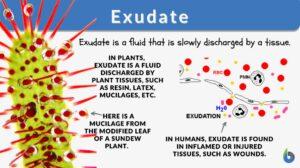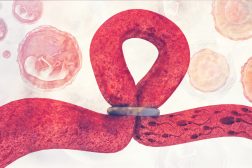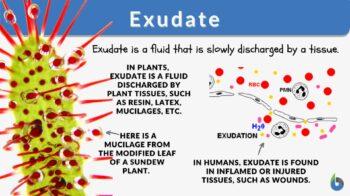
Exudate
n., plural: exudates
[ˈɛɡzjʊdeɪt]
Definition: A fluid exuded by a tissue, such as the exudate from wound and plant exudates
Table of Contents
What is an exudate? The inflammation or injury in a tissue result in increased permeability of the blood vessels that results in leakage or secretion of fluid from blood vessels into adjoining tissues; the fluid secreted is known as exudate. A purulent exudate is one in which there are numerous active and dead neutrophils.
Fibrinous exudate is one that is comprised mainly of fibrinogen and fibrin. In instances wherein there is vascular damage, red blood cells may also escape and be found in the exudate. Plant exudates include viscous materials seeping from interstices or pores. Examples of plant exudates include saps, gums, resins, and latex.
In humans, the exudate can be seen in a wound or even in the eye. Eye exudates are most commonly seen in patients with diabetes having the complication of diabetic retinopathy wherein retinal exudate occurs. Let’s know more about this topic and define exudate in biology and medicine.
Exudate Definition
Exudate is the liquid that is secreted or leaked from the blood vessels in the adjoining tissues as a result of injury or inflammation. Exudate plays an important role in the healing of the wound. Exudate is primarily water with leukocytes, proteins, enzymes required for wound healing, electrolytes, macrophages, platelets, and neutrophils.
Etymology: from “exude”, from Latin “exudare”, “exsudare”, meaning “to sweat out”.
Compare: transudate
Exudate is a bodily fluid that oozes out or is discharged from the tissues during inflammation. The fluid exudes out via the pores or a wound. It may be cloudy or pus-like. It contains exudate cells (e.g. white blood cells), serum, and fibrin.
In animals and humans, an exudate is any of the fluid that oozese out from the blood vessels, especially as a result of a lesion or inflammation. When infection is present, the discharged fluid may contain white blood cells.
What is an example of exudate? Pus is the most common example of exudate.
Trivia: What is pus made of?
Pus is a type of exudate that is thick, yellow/green in color, opaque, and seen in an infected wound. Pus is essentially composed of debris, leucocytes (white blood cells), and microorganisms, which may be dead or living.
The fluid or the exudate is essentially water along with leucocytes, proteins, electrolytes, nutrients, protein-digesting enzymes, such as matrix metalloproteinases (MMPs), growth factors inflammatory mediators, and other cellular exudate components, such as cells like platelets, neutrophils, and macrophages. The release of exudate is a natural response to inflammation or injury. The release of exudate is an essential step in the process of wound healing.
Medicine
What does exudate mean in a wound? In medicine, exudate is defined similarly as pointed out above. Physiologically, the release of exudate is an important step in the process of wound healing. Exudate secretion promotes moist wound healing. Accordingly, the composition, volume, and type of the exudate reveal vital information about the extent of the wound healing.
When a wound or injury occurs in a tissue, the inflammatory pathway of the body is naturally activated. The inflammatory cytokines like bradykinin and histamine, cause the dilation and increase in the permeability of the blood vessels at the site of injury. With increased permeability and inflammatory response, leucocyte-containing fluid is secreted from the circulatory system to the wound site. This fluid leaked or secreted is known as exudate (Figure 1).
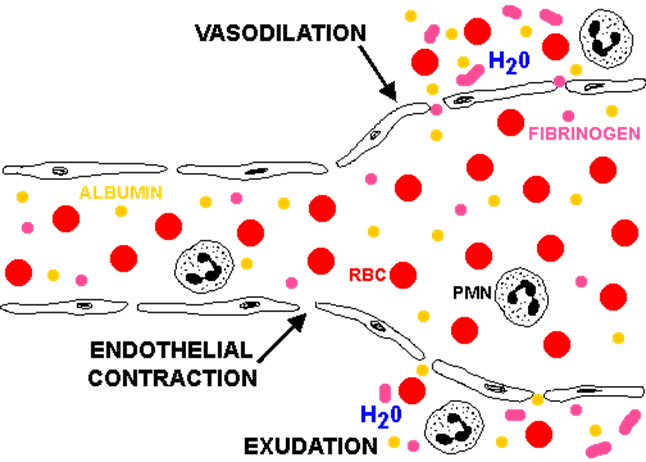
The exudate is quite similar to the blood serum. The severity and nature of the wound determine the composition and the amount of the exudate released. Accordingly, in the acute wound and chronic wound, the exudate will differ.
Let us understand the exudate secreted in acute and chronic wounds.
In the case of an acute wound, with the injury or tissue damage, the inflammatory pathway is activated which results in the dilation of the blood capillaries that results in the leakage of the wound fluid at the wound site. The exudate released contains, enzymes (like matrix metalloproteinases or MMP), leucocytes, proteins, macrophages, and neutrophils.
The exudate thus helps to remove or eliminate the bacteria or microorganisms from the wound site along with the removal of debris from the injury site. The growth factors, cytokines, and proteolytic enzymes required for the process of wound healing are provided by the macrophages present in the exudate.
As the wound healing process occurs, the exudate amount in acute wounds reduces. After the wound, in the initial 48 to 72 hours the exudate contains platelets and fibrin, however as bleeding reduces, platelets and fibrin in the exudate diminish. Also, characteristically, the exudate of the acute wound healing is rich in fibroblast growth factors, epithelial growth factors, and platelet-derived growth factors. Thus, it can be concluded that exudate in acute wounds serves the following functions in the healing wound-
- Creates the necessary environment for moist wound healing
- Providing the essential nutrients needed for cell metabolism at the wound healing site
- Drifting tissue repairing cells to the required wound healing site
- Removal of damaged or dead by the process of autolysis to separate good tissue from bad tissue at the wound healing site
While in the chronic exudative wound, the exudate is strikingly rich in proteolytic enzymes like MMP proenzymes and serine proteinases that function to break down the wound matrix. The exudate in the chronic wound is deficient in the active growth factor. Also, the exudate released in chronic wounds is rich in inflammatory cytokines like interleukin-1 (IL-1) and tumor necrosis factor α (TNF-α). Overall, the exudate composition in the chronic wound is highly inflammatory exudate such that, the tissue regeneration and wound healing process is delayed.
One may wonder what is an inflammatory exudate?
It is the fluid from the wound which has been secreted or leaked out from the circulatory system in the nearby tissues due to inflammation and is made up of inflammatory cytokines, enzymes, and leucocytes.
Types of exudates
Normal wound exudate is thin, watery, straw-colored, odorless, and translucent. However, depending upon the wound healing stage, exudate may vary. Also, an infected wound exudate will differ in color, viscosity, and texture from normal exudate.
Copious drainage is the most severe variety of drainage that requires immediate medical attention as more saturation of the wound with exudate is at 75% or more. It is important to note that as the wound becomes infected, the exudate becomes viscous.
Accordingly, there are different types of exudates, as enlisted below (Table 1 & Figure 2):
Table 1: Types of wound drainage or exudate along with its properties | ||
|---|---|---|
| Type of exudate | Consistency & Colour | Medical implication |
| Serous exudate | Watery, thin, translucent, clear, straw-colored | Clear fluid from the wound or the Normal wound exudate |
| Fibrinous exudate | Thin, presence of strands of fibrin, cloudy | Normal wound healing exudate |
| Serosanguinous exudate | Clear, pink-colored, thin, watery | Normal wound exudate |
| Sanguineous exudate | Red-colored, thin, watery | Exudate from a wounded, bleeding blood vessel |
| Seropurulent | Yellow, tan, opaque, cloudy, thick | Infectious wound |
| Purulent exudate or pus exudate | Thick, Green, Grey, or yellow drainage from the wound | Bacterial infection of the wound with heavy inflammation |
| Hemopurulent or bloody exudate | Red, dark, blood-stained, thick, highly viscous | Inflammatory cells with a bacterial infection |
| Hemorrhagic | Thick red-colored | Indicative of fragile blood capillaries/ trauma/ Infection |
Data Source: Dr. Amita Joshi of Biology Online
Additionally, there is fibrinopurulent exudate which is a kind of purulent exudate or pus exudate but is rich in fibrin and fibrinogen and is seen in bacterial pneumonia, strep throat infection, and rheumatic carditis.
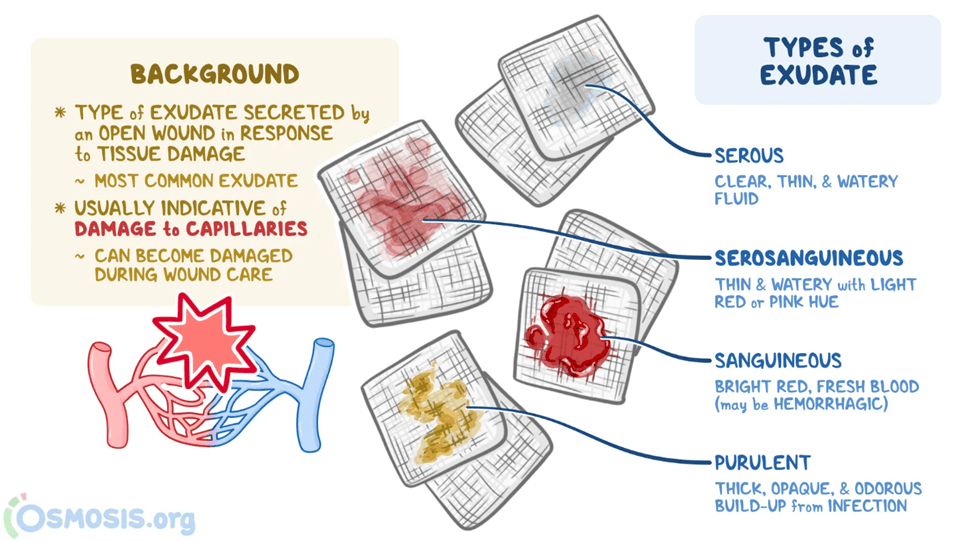
Exudates vs. transudates
Transudate is the ultrafiltered fluid secreted or leaked from the circulatory system due to underlying medical conditions that have altered the venous blood pressure. This secreted fluid is different in composition from the wound exudate. Transudate contains less protein and cells in it. Light’s criteria are used to differentiate between exudate and transudates, as mentioned below:
The fluid is exudate if …
- (Effusion protein:serum protein) ratio > 0.5
- (Effusion lactate dehydrogenase (LDH)/serum LDH) ratio > 0.6
- (Effusion LDH level)> 2/3 of the higher limit for the laboratory’s reference range of serum LDH
Watch this vid about exudate vs. transudate:
Table 2: Clinical difference between Transudate vs Exudate | ||
|---|---|---|
| Characteristics | Exudate | Transudates |
| Total fluid protein | >30 g/L | ≤ 30 g/L |
| (Fluid : serum) protein ratio | >0.5 | <0.5 |
| Specific gravity | >1.015 | <1.015 |
| Cholesterol | ≥ 1.2 mmol/l | <1.2 mmol/l |
| Fluid lactate dehydrogenase (LDH) | >0.67 times of upper limit of normal LDH in serum | <0.67 times of upper limit of normal LDH in serum |
| Fluid/serum LDH | >0.6 | <0.6 |
Data Source: exeterlaboratory.com
Plant Exudates
Plants also secrete certain fluids through their pores or roots especially when injured or diseased. However, root exudate is part of the normal plant metabolic physiology with its surrounding soil and its microorganisms.
So, in plants, what are the examples of exudate?
The plant exudates are referred to as lacquers, latex, resin, mucilage, etc. Generally, the plants’ exudates are carbon-rich and appear as a sticky viscous fluid. Root exudates are rich in organic acids, amino acids, and sugars. Different types of plants produce different kinds of exudates for example, all kinds of latex are not milky.
For example, exudate from the oleander tree (Nerium oleander L.) and leaves of the mulberry tree (Morus spp.) is not milky. Exudates also act as defense mechanisms from herbivore predators. While the resin is produced from specific pores or glandular cells of the plant.
Another example is the mucilage produced by the sundews (carnivorous plants). The plant capture insects using the mucilage exuded by the glands on their leaf surfaces.
 |  |
| Figure 3: Photos of mucilage on sundew’s leaf. The left photo shows an insect trapped by the mucilaginous leaf. A closer look at the sundew leaf on the right photo. Image Credit: Wikimedia (left) and Michal Rubeš, CC BY-SA 3.0. | |
Answer the quiz below to check what you have learned so far about exudates.
References
- Cutting, K. F. (2003). Wound exudate: composition and functions. British journal of community nursing, 8(Sup3), S4-S9.
- Spear M. (2012). Wound exudate–the good, the bad, and the ugly. Plastic surgical nursing : official journal of the American Society of Plastic and Reconstructive Surgical Nurses, 32(2), 77–79. https://doi.org/10.1097/PSN.0b013e318256d638
- Sturkie, P. D., & Griminger, P. (1986). Body fluids: blood. In Avian physiology (pp. 102-129). Springer, New York, NY.
- Verbeken, D., Dierckx, S., & Dewettinck, K. (2003). Exudate gums: occurrence, production, and applications. Applied microbiology and biotechnology, 63(1), 10-21.
- Vowden, K., & Vowden, P. (2003). Understanding exudate management and the role of exudate in the healing process. British Journal of Community Nursing, 8(Sup5), S4-S13.
©BiologyOnline.com. Content provided and moderated by Biology Online Editors.

